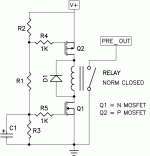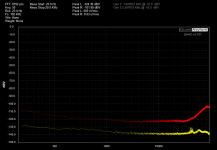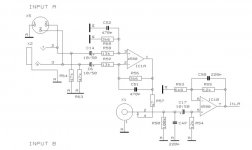You can always put relays at the output if you are concerned. I have an
easy circuit for slow-on / fast-off relay driver.
I would love to see your "slow-on / fast-off relay driver circuit. I didn't see it in the articles at First Watt. Can you share it?
Jac
Here it is. R1, R2, and R3 are chosen to be high impedance so as to slowly charge C1 and activate the normally closed relay. 47K for R1 is maybe appropriate.
You want to develop about 5 volts max on the N channel Mosfet Gate, which should be more than enough, and you don't want much excess on the P channel Gate voltage, as that will slow down the turn-off when the supply voltage drops.

You want to develop about 5 volts max on the N channel Mosfet Gate, which should be more than enough, and you don't want much excess on the P channel Gate voltage, as that will slow down the turn-off when the supply voltage drops.

Attachments
Last edited by a moderator:
I came upon this excellent project while searching for a solution to a noise problem I've been having with the 2x4 HD. Will this circuit output less noise than the miniDSP? Thanks!
Hi,
what kind of noise do you get under what circumstances using the miniDSP? I replaced my miniDSP 2×8 by two of the LXmini boards. Even without housing, there is hardly any audible noise. My speakers are about 90 dB/W @ 1 m. I had no noise problems with the miniDSP either.
Cheers
Last edited by a moderator:
miniDSP (boxed) without input (only power) connected to a Behringer A500 at max volume, produces a very audible hiss. Amps without input are dead silent, so it must be the DSP. Tried different power supplies and different outlets - no change, so I figured the amps are amplifying the idle noise of the miniDSP? I have seen this reported by other users and the conclusion was that devices of this type just output more noise than analog equivalents.
I am using the LXminis. The reason I want my amps at full blast is that at lower than max, they introduce distortion (known problem with these amps).
I am using the LXminis. The reason I want my amps at full blast is that at lower than max, they introduce distortion (known problem with these amps).
miniDSP (boxed) without input (only power) connected to a Behringer A500 at max volume, produces a very audible hiss. Amps without input are dead silent, so it must be the DSP. Tried different power supplies and different outlets - no change, so I figured the amps are amplifying the idle noise of the miniDSP? I have seen this reported by other users and the conclusion was that devices of this type just output more noise than analog equivalents.
I am using the LXminis. The reason I want my amps at full blast is that at lower than max, they introduce distortion (known problem with these amps).
I'm not sure where you read that regarding distortion, but it's incorrect. If using the RCA inputs on the A500, you should have the level controls at approximately the 2 o'clock position. That yields 28db voltage gain and reduced distortion and noise. It's actually preferable to use the XLR inputs (with an appropriate RCA/XLR adapter) if using a typical unbalanced interface. In that case the level controls can advance to fully CW and still yield 28db voltage gain.
The A500 has some interesting idiosyncrasies/problems.....this is just one of them.
Dave.
Last edited by a moderator:
Thanks, Dave! Will try it out! I have seen some mods where the volume (gain?) control of this amp is bypassed and the amp becomes a regular "no-nonsense" amp. I assume that means that those controls are fixed to be always at max? I was hoping that building this circuit would introduce less noise and allow me to do said modifications. I will build this circuit anyway, just wondering if it will help in this regard.
Cheers!
Cheers!
Last edited by a moderator:
It took me a while to find a quiet 5VDC supply for my MiniDSP but my noise problem was more of a buzz or hum. The NP analog design sounds much better to me as follows:miniDSP (boxed) without input (only power) connected to a Behringer A500 at max volume, produces a very audible hiss. Amps without input are dead silent, so it must be the DSP. Tried different power supplies and different outlets - no change, so I figured the amps are amplifying the idle noise of the miniDSP? I have seen this reported by other users and the conclusion was that devices of this type just output more noise than analog equivalents.
I am using the LXminis. The reason I want my amps at full blast is that at lower than max, they introduce distortion (known problem with these amps).
1) More headroom, lower overall noise floor. MiniDSP D-to-A outputs are a circuit design weak point.
2) Less woofer over-excursion, reduces woofer distortion
3) Smoother upper mid-hi equalization, reduces phase shift problems introduced by the Linkwitz DSP filter design which actually detracts from any benefit of the more precise EQ. Overall sound is smoother and more listenable, with no loss of detail. No noise, hiss or hum. NP circuit JFET output impedance is set by 100 ohm resistors. MiniDSP outputs are shown as buffers, possibly with a higher output impedance than the NP circuit. So NP circuit may help with Behringer. Behringer A500 has Chinese copy of 4580 opamp configured as balanced input.
Last edited by a moderator:
For reference, this is the difference in noise floor between the LXmini-ASP and a 2x4HD unit. ASP...yellow. DSP...red. (The miniDSP unit employs some noise-shaping.)
It's certainly noticeable in bench testing, but really shouldn't be in actual usage. With my 2x4HD unit connected in my setup, I can only hear a faint noise from the LXmini tweeter with my ear just a few inches away. And some of that is power amp idling noise.
Also, take a look at Amir's results in testing the 2x4Hd unit over on ASR.
Review and Measurements and miniDSP 2x4 HD DSP and DAC | Audio Science Review (ASR) Forum
Dave.
It's certainly noticeable in bench testing, but really shouldn't be in actual usage. With my 2x4HD unit connected in my setup, I can only hear a faint noise from the LXmini tweeter with my ear just a few inches away. And some of that is power amp idling noise.
Also, take a look at Amir's results in testing the 2x4Hd unit over on ASR.
Review and Measurements and miniDSP 2x4 HD DSP and DAC | Audio Science Review (ASR) Forum
Dave.
Attachments
Last edited:
miniDSP (boxed) without input (only power) connected to a Behringer A500 at max volume, produces a very audible hiss. Amps without input are dead silent, so it must be the DSP. Tried different power supplies and different outlets - no change, so I figured the amps are amplifying the idle noise of the miniDSP? I have seen this reported by other users and the conclusion was that devices of this type just output more noise than analog equivalents.
I am using the LXminis. The reason I want my amps at full blast is that at lower than max, they introduce distortion (known problem with these amps).
When you have the miniDSP powered without input, is the input shorted? When you have an input connected and turned on or when you have shorted inputs, the ouput impedance of the source before the DSP is low and the DSP/amp should be able to have less noise. With open inputs, the impedance is very high.
I haven't built mine yet, but 6L6 in post 398 says that the analog crossover with the wall wart power supply is quiet.
I'm not sure where you read that regarding distortion, but it's incorrect.
If using the RCA inputs on the A500, you should have the level controls at approximately the 2 o'clock position. That yields 28db voltage gain and reduced distortion and noise.
It's actually preferable to use the XLR inputs (with an appropriate RCA/XLR adapter) if using a typical unbalanced interface. In that case the level controls can advance to fully CW and still yield 28db voltage gain.
The A500 has some interesting idiosyncrasies/problems.....this is just one of them.
Dave.
Interesting that pin 2 of XLR or Tip of 1/4" (I assume with pin 3 and/or Ring grounded) would work better. Maybe because the separate RCA input circuit is set to an input impedance of 100K ohms (see schematic).
Attachments
No, the input impedance of the RCA connection is 11k ohms.
The XLR input is a straightforward differential amplifier. Either pin 2 or pin 3 could be grounded and the same result would be expected. Except for polarity, obviously. For info, with the gain control at maximum CW, the voltage gain of the amplifier is 39db via the RCA input, and 27db via the XLR input. That can also be seen from inspection of the IC1A stage.
We're getting well afield of the topic here. There is already numerous threads here on DIYaudio.com regarding the A500 amplifier.
There is already numerous threads here on DIYaudio.com regarding the A500 amplifier.
Dave.
The XLR input is a straightforward differential amplifier. Either pin 2 or pin 3 could be grounded and the same result would be expected. Except for polarity, obviously. For info, with the gain control at maximum CW, the voltage gain of the amplifier is 39db via the RCA input, and 27db via the XLR input. That can also be seen from inspection of the IC1A stage.
We're getting well afield of the topic here.
Dave.
Last edited by a moderator:
Suitable for Linn Keilidh?
Having completed a pair of ACA 1.6 and just now an Aksa Lender preamp, I'm interested in trying an active crossover for my current Linn Keilidh speakers. Would the LX-mini crossover be a good option for this application? Or are there any others that anyone has tried?
Having completed a pair of ACA 1.6 and just now an Aksa Lender preamp, I'm interested in trying an active crossover for my current Linn Keilidh speakers. Would the LX-mini crossover be a good option for this application? Or are there any others that anyone has tried?
Having completed a pair of ACA 1.6 and just now an Aksa Lender preamp, I'm interested in trying an active crossover for my current Linn Keilidh speakers. Would the LX-mini crossover be a good option for this application? Or are there any others that anyone has tried?
LX Mini crossover is specialized. It has a 50 Hz bump in the low pass and a 3K Hz dip with rising response above that in the high pass. This is customized for the specific SEAS drivers used in the LX Mini loudspeaker design. You can modify the crossover for other biamp applications but that requires knowing what you want, how to do the filter design and and a willingness to cut and jumper the PC board as required.
Having completed a pair of ACA 1.6 and just now an Aksa Lender preamp, I'm interested in trying an active crossover for my current Linn Keilidh speakers. Would the LX-mini crossover be a good option for this application? Or are there any others that anyone has tried?
From pictures of the passive xo it can be guessed it is just a 12 dB filter. This would be easily done with the LX mini crossover. You need to know the parts values of the passive xo components and the impedance of the woofers and tweeter. You could either calculate parts for the active xo from that or start with DSP first, find your best filter setting and then implement it in the analogue xo. This is how I did it. However, you should know a little about filters (enough to read in the www) and have a measurement setup, i. e. calibrated mic and software. This could be bundled with the dsp.
From pictures of the passive xo it can be guessed it is just a 12 dB filter. This would be easily done with the LX mini crossover. You need to know the parts values of the passive xo components and the impedance of the woofers and tweeter. You could either calculate parts for the active xo from that or start with DSP first, find your best filter setting and then implement it in the analogue xo. This is how I did it. However, you should know a little about filters (enough to read in the www) and have a measurement setup, i. e. calibrated mic and software. This could be bundled with the dsp.
I recommend TubeCAD Filter Designer for $10. Eliminates having to do the math. I have attached the LT Spice model for the LX mini crossover with section 1 of the LPF removed and section 2 of the HPF removed in order to model a simple 12dB/oct 2-way. Values are for 260 Hz crossover point, not at all appropriate for your loudspeakers, I had worked this up for a different project. Values are easily changed in LT Spice for your specific application.
Attachments
- Home
- Amplifiers
- Pass Labs
- LX-mini Crossover Article



